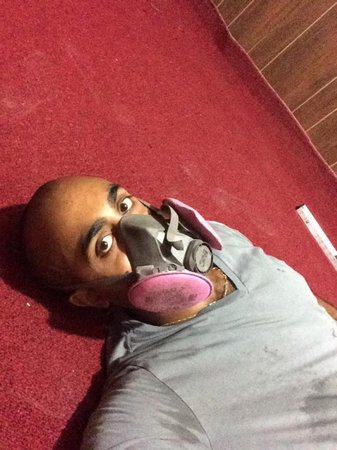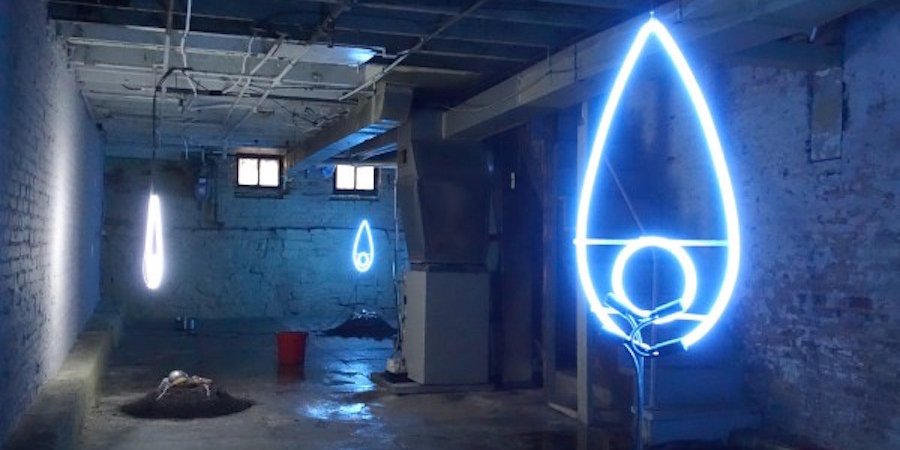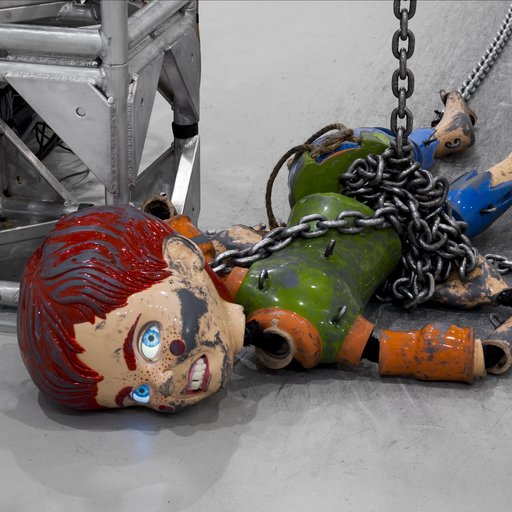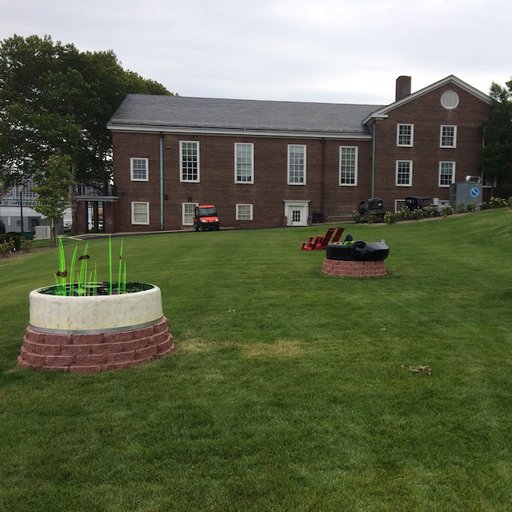Rowhouse Project is a blue row house nestled among several others on Huntingdon Avenue in Baltimore City. It’s unassuming enough. There’s no sign, no symbol to suggest that behind this peeling blue façade is a contemporary art space. Residents don’t seem to pay it much notice. A man who lives next door routinely sits on his stoop or stands watchfully behind his screen door, but really just to pass the time. In line with the space's obscurity, the man who runs it also wishes to remain anonymous. For our purposes, let’s call him Shawn.
Shawn, along with his fiancée (let's call her Lydia), plays an important role in both the functionality of Rowhouse and the overall rhythm of its exhibitions. When he began thinking about the project, he wanted to make a space that could exist simply as a laboratory for artists without any of the noise or extraneous factors that often make the New York art world a difficult and constraining place. He purchased the building in 2014 and established the project with the intent that it would have a three-year lifespan, each season devoted to a single artist. At the end of the three years, he would sell the space. Further, as the project’s lifespan grew closer to its end, the space would seemingly grow younger—cleaned up, altered, and refurbished across the successive shows—as it prepared to go back to market.
 All photos show the installation of Ajay Kurian's "Work Harder Under Water"
All photos show the installation of Ajay Kurian's "Work Harder Under Water"
This created exhibition slots that different artists would prefer at different times, with some appreciating the dilapidated state at the beginning and others requiring more finished environs for their work. When Shawn acquired the house, it was a confused domestic ruin of mismatched wallpapers, dim lighting, and a plenitude of smells coming from the highest kitchen cabinets where the previous owner couldn’t reach. The basement was overrun with cats and rats and reeked of urine. Its old plaster walls were cracked and failing, its floors were peeling, the ceilings were on the cusp of collapse, and a patina of dust equalized every surface. The entire space felt precarious, as if the only thing holding it together were rolls of Scotch tape.
The space has changed quite a bit since then, having undergone the various cosmetic and structural changes that each exhibition has occasioned. Now it was my turn. My exhibition, "Work Harder Under Water," was the last one before Shawn was to begin the next step of renovations, which would require gutting the remains of the space and installing new fixtures and drywall. This gave me an enormous amount of liberty. Short of destroying the space entirely, I could alter what I wanted—and I did. I requested that Shawn tear out the ceilings in several rooms, completely hollowing them out on the top floor; that he skin the walls down to their primary wooden slats in the first two rooms; and that he peel off another layer of wallpaper in the others, revealing yet another psycho-sediment (and leaving some of the exhibition’s atmospherics to chance).

Despite Shawn having done much of the demolition work for me beforehand, the week of install was daunting. We still had to hang a giant sculpture from the skylight, construct a series of pipes to make intentional water drips, and build out one space with fake wood paneling and carpeting. I still had to perfect one sculpture (of a child urinating in the mouth of another), finish another sculpture of a sledgehammer that I hollowed out in order to fill with a series of neodymium magnets, and wire three neon pieces.
We were trying to maintain an ethic where we would get one room completely clean and then move on to the next in order to not get overwhelmed, but this strict ethic collapsed when installing the paneling. With each swing of the hammer, decades-old plaster would collapse to the ground, sending up plumes of dust and black mold hidden behind the walls. What would have taken no more than a few hours in a conventional space took nearly two days—and on the second day, when I could see our work mounting and our time fleeting, nervousness and frustration had built to such a pitch that I was beginning to lose my cool. Shawn, noticing my shortening patience and lengthening string of expletives finally pulled me aside: “Ajay, you just have to remember, the house always wins.”

This piece of wisdom defined the rest of the install, becoming the daily mantra, a neurotic phrase that surprisingly kept insanity at bay. Whenever we would clean a space and were just about to move on, suddenly a chunk of the ceiling would collapse onto the floor, undoing yet another hour of work, and all we could do was look at each other and repeat this incantation. We were protected from ourselves this way. It also opened up the show, made it looser, more urgent. The works, rather than defying the house, started to learn from it. Knowing they had been beaten allowed the sculptures to surrender, and become stronger because of it.
As frustrating as it was in the moment, in a way I had suspected it would be like this before installing. A space such as Rowhouse is not one that you want to try to defeat—it’s one that you want to work with and attempt to understand, remaining open to its conscious and unconscious suggestions. You can’t really know where things would end up in advance, but that’s why the install remains so important to me. Despite it being a rather grueling process, particularly with uncompromising spaces like this one, it’s also one of the most rewarding. You see things take shape; you see the laboratory become the finished work, and you marvel at what the conditions of love and hate can do to a sculpture, an installation, and an exhibition.

The result is almost kaleidoscopic—so many decisions affecting physical and mental space that the experience becomes a strange set of interwoven, tinted layers. Responding to a site allows the work to form a bonded vernacular, a kind of dialogic state that elucidates how an object lives in constant relation to its surroundings while maintaining its own contained mystery. It is the terrible dialectic of surrender and labor that all artists must learn to navigate for themselves. In each place they will work or show, it will be different.
The opening of the show was bizarre and wonderful. Because I grew up in Baltimore, I had well-wishers come from so many different parts of my life—friends I’ve known since I was two, friends from high school, family friends, artist friends, my students, and much of the local Baltimore art scene all came. Sebastian Black, Quintessa Matranga, Rafael Delacruz, Stephen Shaheen, and Mithra Lehn drove down together. Sebastian Black is a painter and has often been someone I’ve relied on for confirming if the words I use are the right ones. Quintessa is also an artist. Rafael is an artist and my occasional studio assistant and helped me quite a bit on this project; he and Quintessa also happen to be together. Steve is my studio mate. Mithra is my partner of six years and a PhD student studying philosophy.

Elena Tavecchia (aka the artist Lucie Fontaine) also came with a few friends of her own. Van Hanos, painter, arrived in a yet another car. Margaret and Oliver, my gallerists at 47 Canal, had come down in the afternoon so that we could spend the day together, but I ended up working till the very last minute before the opening. Jamian Juliano Villani, a painter, traveled down on the train, arriving late and christening the exhibition by adding her removed rotten teeth to a sculpture of mine, a collaboration we had been planning for a bit. Inside two Cup O’ Noodles containers were little pools of neem oil, but each was finished differently: one was sprinkled with my body hair, the other with Jamian’s teeth. The piece is titled Revenants.
It was great to see all these people, so many of whom had helped me in myriad ways. Projects such as these require many others to achieve. It’s through others that we find the license to do what we need to, and it’s all the more generous when this is granted and not taken. Companionship and friendship between artists is often romanticized, defining historical milieux through biography and bar fights. Those narratives seem off. Perhaps today it’s easier to believe friendship between artists to be based more on who makes it into the rarified world of market darlings—the ones who become moneyed stars—as if the art world is simply an incestuous, dollar-driven world where intimacy is defined by financial advancement, an empty castle propped up on the backs of bankers, moguls, and celebrities.

This also seems terribly wrong. I don’t mean to say that there isn’t something of truth in either of these generalized indictments, but it misses the more important and meaningful sense of artistic friendship, one that isn’t drenched in machismo or money, but one that is still small and personal, and stupid. The repartee of texts between artists may be a new way to inform biography. My phone can attest to how many pictures and thoughts get sent to various people, heavily to Jamian. She saw much of the show come together, germinate, and become something completely different, and the result is an important form of shared investment that means something for both of us, both creatively and personally—so much so that after I walked her through the exhibition, reaching that last room with the damned carpeting and paneling, she had tears in her eyes as she congratulated me. She was as proud as I was.
Others shared the show, too. The relationship between artist and assistant is one that is new to me and which I thought would be difficult and fraught, but Rafael and I just work well together. Rafael has not yet been jaded enough to keep his emotions girdled. Although he’s pretty effortlessly cool, he still says “Wooow” with real awe, still says “amazing” because he really is amazed, and says, “I don’t really know,” when he doesn’t in fact know something. Having that energy around helped me know when to stop, when to keep going, and when maybe some of the dumb things I did by mistake were the things I should pursue.

Then, my studio mate Steve—a burly sculptor with a heart of gold would lend a hand, an eye, a car, and a drink whenever needed—let me borrow tools and space whenever I needed, and took hours of his day to fine-tune things that I couldn’t do on my own. (He’s so good-hearted and intelligent that he’s nearly a puzzle.) Lastly, it goes without saying that Mithra bore the brunt of my outbursts, over-sharing, good ideas, bad ideas, and tangents. She is my collaborator par excellence.
Having all of these people helping me out in so many ways gave the show even greater urgency. I suppose that’s what makes you work like you’re trying to outrun the devil and hope your laces are tied. But the singular authorship of any show or any great work is a myth. It’s never one man or woman. It always takes a house. And you know what they say about the house.
Ajay Kurian is an artist, curator, and writer who shows with New York's 47 Canal Gallery. His work is currently on view at MoMA PS1's "Greater New York." This is the second installment of his new column, Jottings.
RELATED LINKS
How Making Public Art Almost Broke Me—and Why Everyone Else Wants to Break Public Art

























